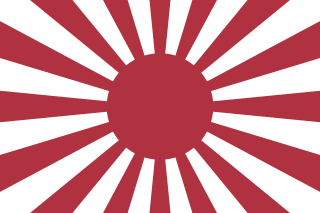
Conscription, also known as the draft in American English, is the practice in which the compulsory enlistment in a national service, mainly a military service, is enforced by law. Conscription dates back to antiquity and it continues in some countries to the present day under various names. The modern system of near-universal national conscription for young men dates to the French Revolution in the 1790s, where it became the basis of a very large and powerful military. Most European nations later copied the system in peacetime, so that men at a certain age would serve 1 to 8 years on active duty and then transfer to the reserve force.

The Finnish Defence Forces (FDF) are the military of Finland. The Finnish Defence Forces consist of the Finnish Army, the Finnish Navy, and the Finnish Air Force. In wartime, the Finnish Border Guard becomes part of the Finnish Defence Forces.

A salute is usually a formal hand gesture or other action used to display respect in military situations. Salutes are primarily associated with the military and law enforcement, but many civilian organizations, such as Girl Guides, Boy Scouts and the Salvation Army use formal salutes. Ordinary civilians also salute informally to greet or acknowledge the presence of another person, such as a tip of the hat or a hand wave to a friend or neighbor.

A soldier is a person who is a member of an army. A soldier can be a conscripted or volunteer enlisted person, a non-commissioned officer, a warrant officer, or an officer.

Mobilization is the act of assembling and readying military troops and supplies for war. The word mobilization was first used in a military context in the 1850s to describe the preparation of the Prussian Army. Mobilization theories and tactics have continuously changed since then. The opposite of mobilization is demobilization.

The Imperial Japanese Army (IJA) was the principal ground force of the Empire of Japan. Forming one of the military branches of the Imperial Japanese Armed Forces (IJAF), it was controlled by the Imperial Japanese Army General Staff Office and the Army Ministry, both of which were nominally subordinate to the Emperor of Japan, the supreme commander of IJAF. During the 20th century, an Inspectorate General of Aviation became the third agency with oversight of the IJA. At its height, the IJA was one of the most influential factions in the politics of Japan.

Military service is service by an individual or group in an army or other militia, air forces, and naval forces, whether as a chosen job (volunteer) or as a result of an involuntary draft (conscription).

Since 1914, Greece has had mandatory military service (conscription) of 12 months in the Army, Navy and the Air Force for men between the age of 19 to 45. Citizens discharged from active service are normally placed in the Reserve and are subject to periodic recall of 1–10 days at irregular intervals.

The Egyptian Army, officially the Egyptian Ground Forces, is the land warfare branch of the Egyptian Armed Forces. It is the largest service branch of the Egyptian Armed Forces. It was known as the Royal Egyptian Army until the declaration of the Republic and the abolishment of the monarchy on 18 June 1953.

A reservist is a person who is a member of a military reserve force. They are otherwise civilians, and in peacetime have careers outside the military. Reservists usually go for training on an annual basis to refresh their skills. This person is usually a former active-duty member of the armed forces, and they remain a reservist either voluntarily, or by obligation. In some countries such as Israel, Norway, Finland, Singapore, and Switzerland, reservists are conscripted soldiers who are called up for training and service when necessary.

In Turkey, compulsory military service applies to all male citizens from 21 to 41 years of age. It is 6 months for all males regardless of education degree. Different rules apply to Turks abroad. For Turks with multiple citizenship, the conscription lapses if they have already served in the army of another country.

The allotment system was a system used in Sweden for keeping a trained army at all times. This system came into use in around 1640, and was replaced by the modern Swedish Armed Forces conscription system in 1901. Two different allotment systems have been in use in Sweden; they are the old allotment system and the new allotment system, the latter often referred to as just "the allotment system". The soldiers who were part of these systems were known as "croft soldiers" due to the small crofts allotted to them.
The Terrace mutiny was a revolt by Canadian Army soldiers based in Terrace, British Columbia during the Second World War. The mutiny, which began on November 24, 1944, and ended on November 29, 1944, was the most serious breach of discipline in Canadian military history. The mutiny was triggered by the rumour that conscript soldiers based on the home front would be deployed overseas.

Conscription in Russia is a 12-month draft, which is mandatory for all male citizens who are between 18 and 30 years old, with a number of exceptions. Avoiding the draft is a felony under Russian criminal code and is punishable by up to 26 months of imprisonment.

In the United Kingdom, military conscription has existed for two periods in modern times. The first was from 1916 to 1920, and the second from 1939 to 1960. The last conscription term ended in 1963 although many soldiers chose to continue in the service beyond 1963.

Conscription in Finland is part of a general compulsion for national military service for all adult males defined in the section 127 of the Constitution of Finland.

The Imperial Russian Army or Russian Imperial Army was the armed land force of the Russian Empire, active from 1721 until the Russian Revolution of 1917. It was organized into a standing army and a state militia. The standing army consisted of regular troops and two forces that served on separate regulations: the Cossack troops and the Muslim troops.

Mario Benjamin Menéndez was the Argentine governor of the Falklands during the 1982 Argentine occupation of the islands. He also served in the Argentine Army. Menéndez surrendered Argentine forces to Britain during the Falklands War.

Switzerland has mandatory military service in the Swiss Army for all able-bodied male citizens, who are conscripted when they reach the age of majority. Women may volunteer for any position. Conscripts make up the majority of the manpower in the Swiss Armed Forces.

France was the first modern nation state to introduce universal military conscription as a condition of citizenship. This was done in order to provide manpower for the country's military at the time of the French Revolution (1789–1799). Conscription in France continued in various forms for the next two centuries, until being phased out from 1997 to 2001.











